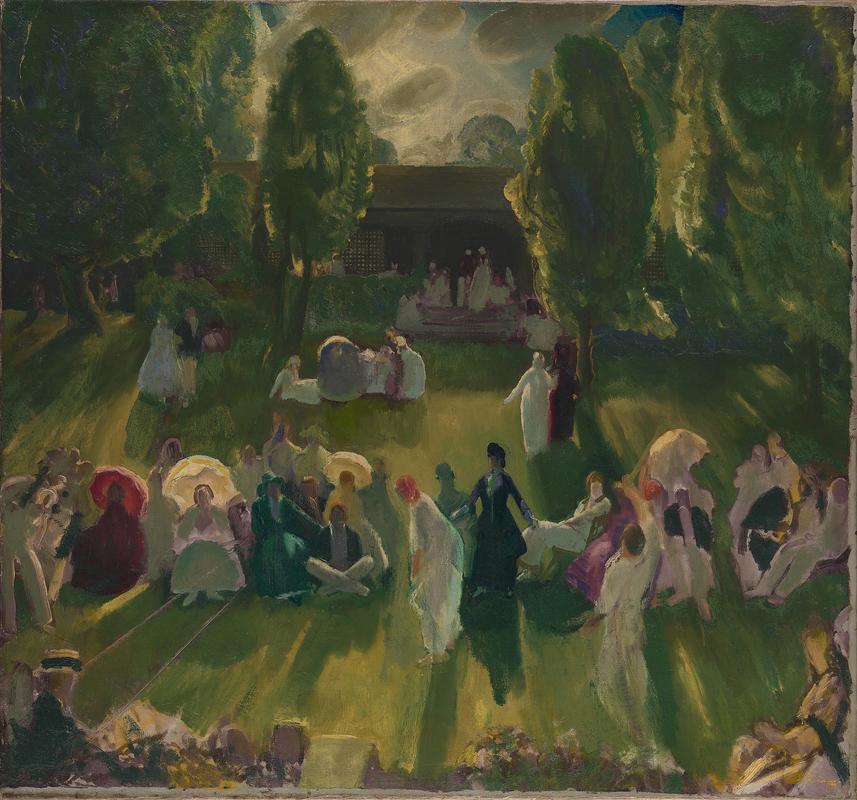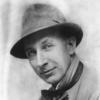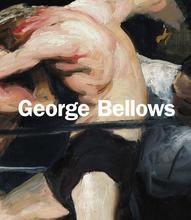More about Tennis at Newport
- All
- Info
- Shop

Contributor
George Bellows steps out of the ring to capture the serene spectators on the lawn of a tennis match in Tennis at Newport.
This is no gritty, brawny boxing match, rather a sport the rich and famous can indulge in. You won’t find any gangsters or degenerates on this freshly mowed court. Tennis at Newport depicts the annual tennis tournament at Newport Casino in August. Forget the boxing gloves and check out those gowns and parasols. This is long before the grandstand was introduced, and the spectators can get up close and personal to the athletes who were without a doubt dressed by the prim and preppy likes of Lacoste.
Tennis really took off post-World War I, as did Bellows’ focus on more joyful subjects. Tennis at Newport focuses less on the game and more on the privileged world of the spectators. Since before the turn of the 20th century, Newport, Rhode Island had been the favorite summering spot of the wealthiest New York families, and in 1881, it was also the home of the very first U.S. Open in tennis (though it had been moved to New York City in 1915). Tennis tournaments (often more social occasion than serious sport) continued taking place in Newport Casino, but during World War I they were cancelled, along with dances. Tennis at Newport was inspired by an invitational tournament hosted by the Newport Lawn Tennis Club held in 1919, in which accomplished athletes were invited to play. But the focus of the painting is more on the crowd than the players.
Perhaps Bellows can relate to the athletes. He was a dude who dug sports, and was even scouted by the Cincinnati Reds before choosing to focus completely on art. Tennis at Newport came from Bellows lounging around Rhode Island for the summer with his family. This was a big deal for the thirty-six year old, who more or less “made it” in the art world thanks to a series of secured commissions leading him to financial stability.
Tennis in Newport goes beyond the sport and into serious art. In 1918, Bellows began applying artist Jay Hambridge’s theory of art to his work. This new theory of composition was based in geometric principles discovered in Greek and Egyptian art. Hambridge called it the theory of "Dynamic Symmetry," and one of its main findings was that many works of art from Antiquity were composed of elements based on the Golden ratio, a ratio often found in Nature. While not an infallible thesis (and indeed, it found many discreditors), it was an attractive idea to many artists, including Bellow's teacher, Robert Henri and Maxfield Parrish, and it is thought Bellows attempted to use Hambridge's theory in Tennis at Newport to make a more attractive composition.
Sources
- Christies, “From the city to the sea – the life and art of George Bellows,” May 15, 2019. Accessed March 23. https://www.christies.com/features/10-things-to-know-about-George-Bello…
- Pollack, Barbara, “The 100 best paintings in New York,” Time Out, January 24, 2019. Accessed March 23, 2020. https://www.timeout.com/newyork/art/the-100-best-paintings-in-new-york
- Shaun Randol, “The art of boxing: George Bellows,” The Mantle. Accessed March 23, 2020. https://www.themantle.com/arts-and-culture/art-boxing-george-bellows
- Southgate, M. Therese, The Art of JAMA: Covers and Essays from the Journal of the American Medical Association. Oxford: Oxford University Press, 2011.
- Weinberg, Helene Barbara, American Impressionism and Realism: A Landmark Exhibition from the MET, the Metropolitan Museum of Art, New York. Brisbane: Art Exhibitions Australia and Queensland Art Gallery, 2009.
- Sotheby's, "George Bellows - Tennis at Newport," May 17, 2012. Accessed December 27, 2020. https://www.sothebys.com/en/auctions/ecatalogue/2012/american-art-n0886…
Featured Content
Here is what Wikipedia says about Tennis at Newport
Tennis at Newport is an oil-on-canvas painting of 1919 by the American artist George Bellows. It depicts one of the earliest editions of the Newport Casino Invitational, a major event on the high society calendar. The painting is in the Metropolitan Museum of Art.
Check out the full Wikipedia article about Tennis at Newport













